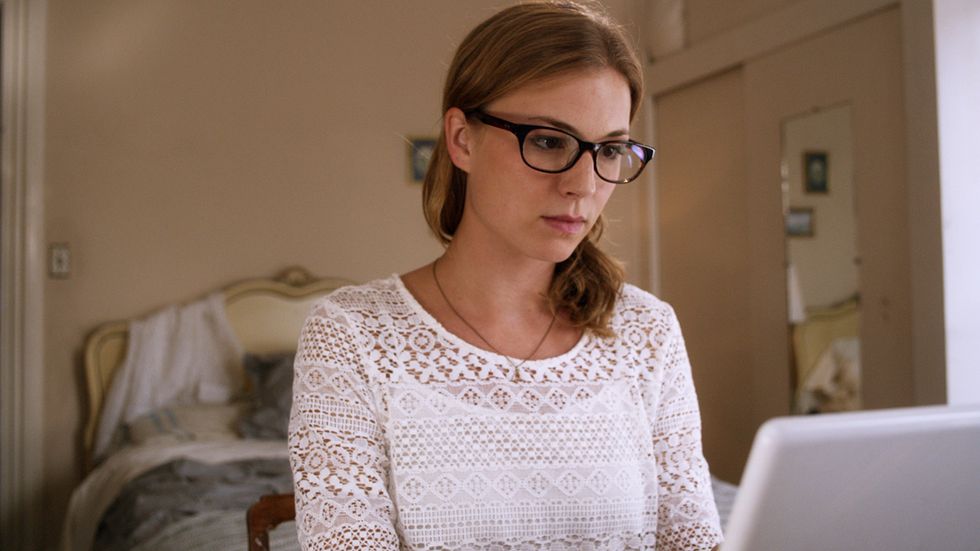“The Girl in the Book,” written and directed by first-timer Marya Cohn, is your typical tale of a tortured artist, but not necessarily in a good way. The film exemplifies Alice Harvey, a 20-something, kind-of-aspiring writer working as an editor’s assistant in New York when she is suddenly forced to revisit her troubling past when a novelist she knew as a teenager returns to her life.
Firstly, and ironically, the film is not based on a book, which is a little disappointing. However, Alice does write her own books -- she wins a writing contest at just 16, and is forever praised and pressured by her mostly absentee parents, which is essentially how she meets Milan (Michael Nyqvist). As a writer himself, he wiggles his way into her life by offering to read some of her work, and eventually develops both an emotional and somewhat sexual relationship with her -- all of which he incorporates into his bestselling novel (cue light bulb). When Alice tells her mother about their connection, both she and Alice’s father take Milan’s side when he claims she made it all up. This (we think?) is what drastically changed her into the wannabe-emotionless adult she is present day.
We gain a great deal of this information through an abundance of ambiguous flashbacks, which do little to explain the nature of the situation -- Cohn makes it really hard for the viewer to distinguish if their relationship was truly consensual. Of course, this could also be attributed to the actress who portrays young Alice (Ana Mulvoy-Ten) -- who, while we’re on the topic, doesn’t resemble Emily VanCamp at all. Emily VanCamp -- whom you may recognize from the acclaimed television series “Revenge” -- does a mediocre job of looking mildly disappointed in herself after a one-night stand, but apparently doesn’t stray far from her customary mannerisms as it was fairly difficult to distinguish Alice Harvey from Emily Thorne, a role that will obviously follow her forever. Michael Nyqvist, however, did a fantastic job of being British and creepy, which was the extent of our expectations for him.
But, like most of the movie’s characters, the documentary feel (think: shaky camera, too many random close-ups) and young Alice’s sparse but still unnecessary narration felt a little out of place. And while we can probably all appreciate a young, beautiful New Yorker with an I-do-what-I-want attitude, there’s only so much of that we can take. The first part of the movie felt very drawn out, like there was no light at the end of this troubled girl’s very long tunnel. She cheats on her boyfriend (with her best friend’s son’s nanny, who is like 10 years younger than her, might I add), tries and fails to win him back when he dumps her, and kind of confronts the man who maybe abused her 15 years ago. Emphasis on kind of and maybe. But, unlike the beginning, the movie ends with Alice seemingly instantaneously transforming into someone who barely resembles the person she was half a second ago. She went from that person who hides in the bathroom at her own surprise party to a lovesick blogger making headway in her career -- which is really great for her, but quite the opposite for everyone else because we don’t exactly know how or why it happened (the lovesick part or the blogger part or the career part).
But, to avoid completely bashing on a movie that actually wasn’t that bad as a whole: there were some mise-en-scene techniques (essentially the "visual theme" of a production) that I’m usually fond of in other films, and this one was no exception. I’m a sucker for the use of costume and setting to implicitly explain certain aspects or characteristics of a person’s life. For example, Cohn resorted to dressing young Alice and decorating her bedroom in all floral patterns, creatively conveying her innocence and inexperience, which interestingly (though disturbingly) juxtaposed the not-so-innocent acts that were being performed in the same vicinity. It was also an intriguing contrast to adult Alice’s borderline professional, but still obviously lazy clothing in monotonous tones -- a too-accurate depiction of her current life after whatever went down with Milan.
Needless to say, “The Girl in the Book,” which can be found on Netflix, embodied a near-perfect depiction of a “tortured writer.” But if that sounds familiar, it’s because it is. The idea, though hopeful, didn’t provide enough uniqueness to set it apart from adaptations of the same idea that have been around longer than Alice has been in a bad mood (which is to say, a very long time). Its enigmatic nature only makes you yearn for Nicole Kidman as Virginia Woolf in “The Hours.” However, if you thoroughly enjoy a lack of variety in your camera angles, or love Emily Thorne and want to watch her in a different, completely un-”Revenge”-like setting as the same exact character, this might be the movie for you. But even then, I’m not too sure.















